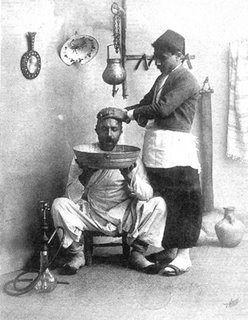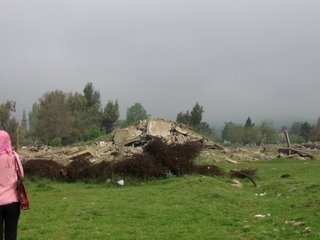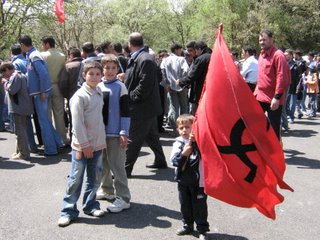Well, here it is, the eagerly (!) anticipated blog documenting Dave's adventures in the venerabe city of Damascus. I can almost feel your sense of excitement. Here's the story so far.
1)
We have now been in Damascus for two days and we are having a fantastic time.
Yesterday morning was a little manic, arriving in a sleepless daze and being ambushed by a horde of taxi touts. It was too much to take in, the city was absolutely buzzing, even at 6.30 in the morning - crowded with people buying from the souqs - then suddenly we were dropped off,
disoriented outside a fairly modest looking alley which was where our hotel is. At that time everyone was asleep - we had to wake the porter with our banging, and were informed that our room would not be available for many hours.
However, since then it has all been smooth sailing. Our room is modest but the hotel itself is a beautiful Damascene house with a courtyard containing a fountain, frescoes and a canopy of trees.

Everyone has been very friendly and helpful towards us - whether the local cafe owners, waiters in restaurants or even people in the street. We have already looked at one really nice room in a large house shared with a mix of Westerners (French, German, Italian) and Syrians - it is in the city centre for only 75 UK pounds a month!
We are beginning to know our way around and have already explored quite a lot of central Damascus. It is so busy - especially in the early evening, and surprisingly cosmopolitan. There is a real mix of fashions - women's dress ranges from black chador and niqab (face covering) to skin tight bling! The two dominant sounds of the city are the muezzins call to prayer (5 times a day), which has to fight to be heard above the chorus of honking car horns (almost 24 hours a day!). It is noisy at night but I slept well nonethless (so tired!).
The food is excellent and very cheap by our standards. We have been eating so much we are gonna gain so much weight which will be good for me, but C-lo is not so happy at the idea of gaining 5 kilos!
Hope all is well in the UK... London seems a long way away from here at the moment. Take care. You'll hear from me again soon inshallah (there are hundreds of internet cafes!).
2)
Just spent an age composing a long update on our first (busy!) week in Syria but it got lost in transmission (probably too many pictures!).
We have a flat sharing with four others. Its a nice place, rooms on two floors around a shared courtyard in a predominantly Muslim residential area in the centre of the city.

We start Arabic lessons tomorrow.
Today was a sandstorm - weird mix of rain and sand. The sky is a dramatic dull red colour.
It was pretty amazing how the colour of everything has gradually changed, almost imperceptibly until a layer of red dust has descended over the city. Suddenly we are transported to the surface of Mars...

3)
There are a lot of internet cafes, but they are all quite idiosyncratic - unreliable connections, dodgy old keyboards etc. This one is in French Cultural Centre near my Arabic class - its a French keyboard which means many of the letters are in the wrong places - kinda weird, and slow for me to type. But I have a fantastic view looking over the city towards the hill to the north of Damascus and the buildings which creep up its lower slopes.
We will soon get an internet connection installed in our flat, inshallah, which will make it easier to set up a blog and organise our many photos.
Anyways, glad to hear everyone is doing good in their respective parts of the world. It feels like we have been here for ages. The flat is working out well - people are chilled and really interesting.
Since the sandstorm nothing too exciting has happened, been too busy with classes and homework. Its only day two and my teacher has given me about 100 words to learn!!! Buying things from my local area can still be a real effort (though its still surprising how many Syrians
know some English), not least because many words in Syrian dialect are different to the classical Arabic I am learning/have learnt.
It is definitely different here though perhaps not in the ways that you would expect. Damascus is bustling and super crowded yet more leisurely than London, and it feels v safe, provided you do not meddle in domestic politics. Mind you, seems like Syrians do not always trust each other - still the fear of the secret police which can get a little infectious sometimes.
Pictures of the President and/or his illustrious father are ubiquitous, sometimes also with Nasrallah, the leader of Hizbullah. There is clearly an industry churning out patrionic posters which, especially in the city centre, can be huge and commanding.

Most people have mobiles, the guys do not dress too differently from in UK - jeans, trainers etc. Some form of hijab is common but not dominant, and is often worn over tight tops, jeans etc. The infamous black chador is not very common and seems mostly to be worn by the hordes of Iranian pilgrims who come by the coach-load to visit the holy sites here, or by Saudi tourists.
The guys are very into football - first thing they ask is what team I support. Beckham is on posters advertising Pepsi. Most homes have satellite TV - our one has about 250 channels with everything from racy Arabic pop videos (surprising amounts of female flesh on display), Islamic scholars giving judgements, agony aunt shows, dubbed cartoons from US and Japan (Ninja Turtles in Arabic - v funny), cookery programmes and cheesy US TV movies. Oh yeah and BBC World, Euronews etc. Indeed, it seems to C-lo and I that these people have far greater insight and access to our world than we have into theirs.



 In the evening we met some friends and had dinner at the top of the hill, where we admired the lights of the city stretching out to the horizon.
In the evening we met some friends and had dinner at the top of the hill, where we admired the lights of the city stretching out to the horizon. 
 Then it was time to visit the Krak and none of us were disappointed. It is an impressive piece of military architecture, labyrinthine in its complexity with many passageways tantatisingly leading down into the darkness into who-knows what crypts and catacombs. Above ground there remains a relatively well-preserved mix of Gothic, Romanesque and Arabic building styles (the Crusaders surrendered the castle to the Mamluks in 1271). It was quiet – just a large group of Spaniards and a handful of other tourists - and aside from the T-Shirt hawkers and self-appointed guides we were left alone to explore at our leisure.
Then it was time to visit the Krak and none of us were disappointed. It is an impressive piece of military architecture, labyrinthine in its complexity with many passageways tantatisingly leading down into the darkness into who-knows what crypts and catacombs. Above ground there remains a relatively well-preserved mix of Gothic, Romanesque and Arabic building styles (the Crusaders surrendered the castle to the Mamluks in 1271). It was quiet – just a large group of Spaniards and a handful of other tourists - and aside from the T-Shirt hawkers and self-appointed guides we were left alone to explore at our leisure. On the way up and down to the castle we passed through a small hillside village where the locals were friendly and fascinated by us (some children shouted ‘Come and look at the beautiful foreigners!’). We accepted the inevitable offer of a super sugary tea from a weathered man wearing a kufeyya (traditional black/white or red/white head-dress). He chatted to us in Arabic about the village (‘Muslims and Christians here are like one family’) and the local trails and shrines for about half an hour until the sugar had kicked in and it was time for us to hit the road again.
On the way up and down to the castle we passed through a small hillside village where the locals were friendly and fascinated by us (some children shouted ‘Come and look at the beautiful foreigners!’). We accepted the inevitable offer of a super sugary tea from a weathered man wearing a kufeyya (traditional black/white or red/white head-dress). He chatted to us in Arabic about the village (‘Muslims and Christians here are like one family’) and the local trails and shrines for about half an hour until the sugar had kicked in and it was time for us to hit the road again. We spent the evening in the city of Hama. Compared with Damascus it felt more chilled and airy. This was particularly surprising given the trauma suffered by the city in February 1982 when an insurrection led by the Muslim Brotherhood was crushed, killing thousands. The only clue to this bloody moment in the recent past is the visible lack of old buildings in the heart of the city – during the fighting almost all the Old City was destroyed.
We spent the evening in the city of Hama. Compared with Damascus it felt more chilled and airy. This was particularly surprising given the trauma suffered by the city in February 1982 when an insurrection led by the Muslim Brotherhood was crushed, killing thousands. The only clue to this bloody moment in the recent past is the visible lack of old buildings in the heart of the city – during the fighting almost all the Old City was destroyed. But these events seemed very distant as we dined on the banks of the Orontes, serenaded by scores of frogs, and wandered through the city centre souqs, greeted by abayya-clad ladies and teenaged bicylists alike.
But these events seemed very distant as we dined on the banks of the Orontes, serenaded by scores of frogs, and wandered through the city centre souqs, greeted by abayya-clad ladies and teenaged bicylists alike.  I got the impression that not many foreigners spent much time here, which is a shame. If we get the chance I’d like to go back.
I got the impression that not many foreigners spent much time here, which is a shame. If we get the chance I’d like to go back. The interior of the Citadel was a world away from the heat, smells and bustle of Aleppo’s souqs. The covered markets stretch for miles and are rightly famed throughout the Middle East. We were on the hunt for some fabrics for C-lo but a mixture of fatigue and the onset of Delhi belly put a premature end to our visit.
The interior of the Citadel was a world away from the heat, smells and bustle of Aleppo’s souqs. The covered markets stretch for miles and are rightly famed throughout the Middle East. We were on the hunt for some fabrics for C-lo but a mixture of fatigue and the onset of Delhi belly put a premature end to our visit. However, the main purpose of our trip here was not to see sights, it was to eat! We enjoyed the hospitality of my housemate’s sister who had called in her mum as reinforcements to help prepare a feast for us. After the umpteenth course of food (‘Kul!’ – ‘Eat!’), the customary session on the nargileh (water pipe), and a shared glass of arak with her husband, we were all feeling ready to pass out, sitting dozily on the balcony looking out over the ugly concrete town and the beautiful green rolling hills behind.
However, the main purpose of our trip here was not to see sights, it was to eat! We enjoyed the hospitality of my housemate’s sister who had called in her mum as reinforcements to help prepare a feast for us. After the umpteenth course of food (‘Kul!’ – ‘Eat!’), the customary session on the nargileh (water pipe), and a shared glass of arak with her husband, we were all feeling ready to pass out, sitting dozily on the balcony looking out over the ugly concrete town and the beautiful green rolling hills behind. The pit-stop at Musyaf gave us fuel for an epic oxygen-starved 3 hour bus-ride back to Damascus. It was a relief to be dropped off amongst the noise and dust that is becoming so familiar, not least because my guts were starting to be in full rebellion. After some time glued to the hole in the floor which we optimistically call a toilet I decided to put off the planned trip to Beirut for another occasion.
The pit-stop at Musyaf gave us fuel for an epic oxygen-starved 3 hour bus-ride back to Damascus. It was a relief to be dropped off amongst the noise and dust that is becoming so familiar, not least because my guts were starting to be in full rebellion. After some time glued to the hole in the floor which we optimistically call a toilet I decided to put off the planned trip to Beirut for another occasion.
 When we arrived at 8 in the morning it was packed with people, starting cooking fires and reclaiming their territory. However, our uncommunicative mini-bus driver refused to acquiesce in our desire to explore the site. Instead, after an exasperating and seemingly aimless hour-long drive around the countryside we were dropped off at a scenic spot in the foothills where we set up our picnic.
When we arrived at 8 in the morning it was packed with people, starting cooking fires and reclaiming their territory. However, our uncommunicative mini-bus driver refused to acquiesce in our desire to explore the site. Instead, after an exasperating and seemingly aimless hour-long drive around the countryside we were dropped off at a scenic spot in the foothills where we set up our picnic.




 3)
3) Most people have mobiles, the guys do not dress too differently from in UK - jeans, trainers etc. Some form of hijab is common but not dominant, and is often worn over tight tops, jeans etc. The infamous black chador is not very common and seems mostly to be worn by the hordes of Iranian pilgrims who come by the coach-load to visit the holy sites here, or by Saudi tourists.
Most people have mobiles, the guys do not dress too differently from in UK - jeans, trainers etc. Some form of hijab is common but not dominant, and is often worn over tight tops, jeans etc. The infamous black chador is not very common and seems mostly to be worn by the hordes of Iranian pilgrims who come by the coach-load to visit the holy sites here, or by Saudi tourists.